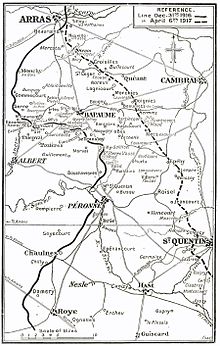Alberich company
Alberich (after the legendary figure Alberich ) was the code name during the First World War for the retreat to the Siegfriedstellung prepared by the German army on the western front between February 9 and March 15, 1917 and then carried out from March 16 to 20 . By clearing the arch between Arras and Soissons , the aim was to shorten the front line and also to thwart the Entente's attack plans for spring 1917.
Process and units involved
The 1st and 2nd Army as well as the right wing of the 7th Army were involved in the retreat, the company was managed by the Army Group "Crown Prince Rupprecht" . The 1st Army in the north gave up all areas north of the Somme and in the area northeast of Bapaume and went back to the new front line Bullecourt – Havrincourt – Banteux – Le Catelet. The 2nd Army cleared the area south of the Somme, gave up the cities of Péronne , Nesle , Noyon , Chauny and Ham and withdrew to the line between Bellicourt - St. Quentin to the Oise at La Fère . In the south, the 7th Army gave up the line between Carlepont - Autrêches - Nouvron, cleared Coucy and moved to the new line between St. Gobain - Brancourt - Vauxaillon - Laffaux corner to the Aisne near Missy (Conde).
Procedure and consequences
The area to be cleared on both sides of the Somme was systematically devastated before the withdrawal (so-called “ scorched earth ” war tactics ) in order to make its military use largely impossible for the enemy. Around 200 localities and the infrastructure, especially the railway lines running there, were completely destroyed; more than 100,000 civilians were deported . From a German point of view, the company was successful and surprised the Entente leadership. The planned destruction - even culturally and historically significant buildings such as Coucy Castle were not excluded - but also strengthened the reputation of the Germans as “barbarians”, as they had been portrayed by the Allied war propaganda from the start.
literature
- Markus Pöhlmann : Alberich, company. In: Gerhard Hirschfeld , Gerd Krumeich , Irina Renz (eds.): Encyclopedia First World War. Schöningh, Paderborn et al. 2003, ISBN 3-506-73913-1 , p. 326 f.
Web links
- Dennis Showalter: Operation Alberich , in: 1914-1918-online. International Encyclopedia of the First World War, ed. By Ute Daniel, Peter Gatrell, Oliver Janz, Heather Jones, Jennifer Keene, Alan Kramer, and Bill Nasson, issued by Freie Universität Berlin, Berlin 2016. doi : 10.15463 / ie1418.11022 .
- Alberich's gruesome work in the villages of the Somme . In: Frankfurter Allgemeine Zeitung , No. 47, February 25, 2009, page 34. (Book review)
Single references
- ^ Reichsarchiv Volume XII. Appendix 7 - The Siegfried Movement, sketch of the situation: late March 1917.


